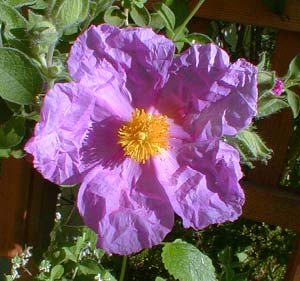
Pink Rock Rose; aka:
Hairy Rockrose, Gum Cistus,
Grey Rockrose, European Rock Rose,
or, Balm of Gilead
"In this refulgent summer it has been a luxury to draw the breath of life. The grass grows, the buds burst, the meadow is spotted with fire & gold in the tint of flowers. The air is full of birds, & sweet with the breath of the pine, the balm-of-Gilead, & the new hay. Night brings no gloom to the heart with its welcome shade."
-Ralph Waldo Emerson
(1803-1882)
(1803-1882)
The evergreen subshrub Cistus incanus creticus is a native of southern Europe & northern Africa, commonly listed with its subspecies name given as a cultivar name, C. incanus "Creticus," while a few botanical experts have regarded it as its own species, C. creticus.
It's extremely heat-hardy but does not suffer in the lower temperate climate of Puget Sound so long as it is in soil with sharp drainage. It is cold-hardy to 10 or 15 degrees F., so long as chilly periods are not extended. It tolerates salt spray, wind, & extremely droughty conditions.
In our small city, it has been planted all along one of our major streets, & is commonly seen along other local roadsides. Starting late spring with reblooms throughout the summer it is very flowerful.
I love the wild Pink Rock Rose but probably would never have planted it since it's already common enough from the city's own plantings. But there were two clumps of it growing up near the house when we first bought the place. With some regret in retrospect, I dug up both clumps & composted them, as one had spread into a doorway & was blocking access, & the other was in an ideal location for a shrub I liked better. In retrospect I should've moved them to the roadside, but as popular wisdom is they don't transplant well when they are old, I decided not to try that. I've since found rock roses to be far hardier than I was advised.
One of those initial two clumps had a bit of root remaining behind, & it regenerated a new shrub. Curiously this location is very shady due to a giant forsythia overshadowing it, plus the arbor I built around the side-door of the house. Rockroses ordinarily need so much sunlight I would not have thought it possible for one to thrive in such a poor location, but it has grown through one side of the arbor & into as much light as it can get, & gets on well enough to bloom well.
Sometimes called "Hairy Rockrose" because of its pubescent stems, it is not a thorned rose, nor even in the rose family. It forms a low-growing shrub of wavy grey-green leaves over which pink flowers with yellow hearts become very numerous. Each flower lasts but a day, but it produces so many consecutive buds that it is continuously in flower for weeks on end.
It is also known as Gum Cistus because the sticky stems exude a resin called Ladanum or Labdanum used as an expectorant, for skin ailments, & for other medicinal purposes. Ladanum has balsamic adhesive qualities making it useful in healing plasters. It burns cleanly with the odor of ambergris so has been used in ages past as a sacred incense.
This resinous "balm" led to this plant being regarded throughout its native range of Spain, Italy, & Greece as one & the same with the biblical "Balm of Gilead." For a discussion of its mythology & biblical associations, see the separate article on The Balm of Gilead.